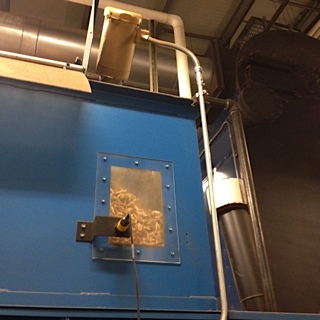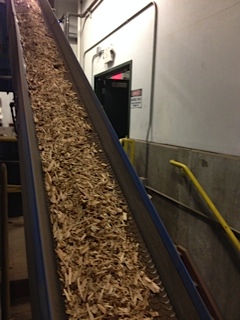In late 2010 the Tok School fired up its new biomass boiler to heat the school. By 2013 it was providing electricity as well and saving the school district about $350,000 per year. Now, those same scrubby trees will help grow fresh vegetables for the district’s students.
 It all starts with a massive pile of wood chips made from trees cut to reduce wild fire risks near the community of Tok, which is surrounded by thick stands of spruce. The chips feed onto a thin conveyor belt that slowly dumps them into a giant boiler.
It all starts with a massive pile of wood chips made from trees cut to reduce wild fire risks near the community of Tok, which is surrounded by thick stands of spruce. The chips feed onto a thin conveyor belt that slowly dumps them into a giant boiler.“We put three pounds of wood into the boiler,” said Scott MacManus over the sound of running turbines and compressors.
MacManus is the school district’s assistant superintendent, and one of the major forces behind this innovative project. He explains the efficient wood boiler produces steam for a turbine that powers the school. Then, the steam warms up glycol that heats the school.
The combined heat and power system saves the school district enough money to employ a counselor and a music teacher. Tok’s 5th graders tinker with their instruments, testing the sounds as they blow into the mouth pieces and bang on the drums. Music teacher Ruth Fastenau tries to pull in their attention so they can play “Merrily We Roll Along.” High school senior Claire Burnham hoists her trombones and helps them out.
“It’s amazing,” Burnham said about the music program. “We used to have one but it ended my third grade year and so when we found out it was coming back, a lot of us were really excited to have music again.”
Burnham will study music at UAF in the fall. Meanwhile, back at the power plant, Macmanus said that even after the new facility heated the entire school, “We have all this extra heat. You see how we have the doors open? We’re just blowing heat out into the air right now.”
Initially the school district wanted to build a heat loop to provide warmth to other community buildings, but they couldn’t find funding for the project. So while they refine that idea, some of the heat is being pumped into a commercial greenhouse.
“The floor is made of woodchips, as insulation. Better than foam, we can lay the beds right on it,” MacManus said as he walked into the plastic high tunnel greenhouse, fans and heaters whirring from the ceiling. “I’m not sure what the temperature is, maybe 70 degrees?”
In front of MacManus, rows of old highway guardrails are filled with soil. As soon
as there’s enough daylight, they’ll be planted with vegetables to feed the district’s students.
“What did I say – spinach, kale, regular lettuce. Probably not too much head lettuce. And then that’s what we’re gonna do right now because we’re wanting to get the salad bar going this spring. So we’ll actually have food on the kids’ plates this spring. So I’ll send you a picture of a plate full of lettuce. That would be awesome.”
 In the summer they’ll plant things like tomatoes and onions that can be processed into sauces and salsas and preserved for winter.
In the summer they’ll plant things like tomatoes and onions that can be processed into sauces and salsas and preserved for winter.Food services coordinator Danni Rutledge said there’s a practical reason for the school to grow vegetables.
“The stuff might last longer because a lot of times by the time we finally get something it’s already a week or two or a month old. So the preservation time will be longer,” she said. “And one of our goals is to have less preservatives in our food.”
The school district is considering cooking and freezing hundreds of pounds of lasagna using the summer vegetables instead of buying it pre-made.
Rutledge said they also want the kids to be able to connect to their foods, even though it’s primarily a commercial enterprise.
“We want to bring the kids out there. We want them to see the process of growing their own vegetables and processing their own vegetables.”
Part of the process is caring for the soil and adding nutrients, which takes us back to the biomass plant and a barrel of ash cleaned from the boiler. MacManus said they will use the ash as fertilizer in the greenhouse. Local gardeners already collect it.
Sometimes, though, it’s not only ash at the bottom of the boiler. MacManus says they briefly had a problem with dirty wood. The silica-heavy pine needles melted in the boiler and left chunks of glass.
Though they’ve had to work through some kinks in the system, he says for the most
part the project has gone smoothly. “There’s nothing in here that’s not been tried and proven. We had a little bit of tweaking to do related to an artic environment.”
The school plans to begin planting vegetable starts in mid-February.
Anne Hillman is the healthy communities editor at Alaska Public Media and a host of Hometown, Alaska. Reach her at ahillman@alaskapublic.org. Read more about Anne here.





